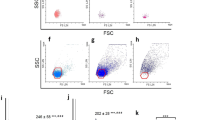Abstract
Human peritoneal macrophages have been obtained from patients with renal disease undergoing chronic peritoneal dialysis, patients with ascites and at laparoscopy. These macrophages in general have both morphological and enzymatic characteristics of activated macrophages, as judged by criteria derived from animal experiments. Human peritoneal macrophages produce a variety of eicosanoids, including leukotriene B4 and leukotriene C4. These cells are suitable for studies onin vitro andin vivo effects of drugs, and for investigation of changes in macrophage activity occurring in human diseases.
Similar content being viewed by others
References
J. Hammerström,Human macrophage differentiation in vivo and in vitro. A comparison of human peritoneal macrophages and monocytes, Acta Pathol. Microbiol. Scand.87, 113–120 (1979).
M. Loos, R. Storz, W. Muller andE.-M. Lemmel,Immunofluorescence studies on the subcomponents of the first component of complement (Cl): Detection of Cl q and Cl s in different cells of biopsy material and on human as well as on guinea pig peritoneal macrophages, Immunobiol.158, 213–224 (1981).
R.J.T. Ouwendijk, F.J. Zijlstra, J.H.P. Wilson, andI.L. Bonta,Production of leukotrienes and prostaglandins by human ascites cells, Eur. J. Clin. Invest. In press (1985).
P.K. Peterson, W.F. Keane, W. Miller, M. Freiberg, D. Staub andH.A. Verbrugh,Human peritoneal macrophage cytotoxicity mediated by cytophilic IgG, J. Infect. Dis.148, 1040–1048 (1983).
H.A. Verbrugh, W.F. Keane, J.R. Hoidal, M.R. Freiburg, G.R. Elliott andP.K. Peterson,Peritoneal macrophages and opsonins: Antibacterial defense in patients undergoing chronic peritoneal dialysis, J. Infect. Dis.147, 1018–1029 (1983).
J.T. Du, M. Foegh, Y. Maddox andP.W. Ramwell,Human peritoneal macrophages synthesize leukotrienes B4 and C4, Biochim. Biophys. Acta753, 159–163 (1983).
I.L. Bonta, M.J.P. Adolfs andM.W.J.A. Fieren,Cyclic AMP levels and their regulation by prostaglandins in peritoneal macrophages of rats and humans, Int. J. Immunopharmac.6, 547–555 (1984).
M.R. Parwaresch, H.J. Radzun andM. Dommes,The homogeneity and monocytic origin of human peritoneal macrophages evidenced by comparison of esterase polymorphism, Am. J. Pathol.102, 209–218 (1981).
S. Becker, J. Halme andS. Haskill,Heterogeneity of human peritoneal macrophages: Cytochemical and flow cytometric studies, J. Reticuloendothel. Soc.33, 127–138 (1983).
R.J. Kurlander, A.F. Haney andJ.R. Gartrell,Human peritoneal macrophages possess two populations of IgG Fc receptors, Cell. Immunol.86, 479–490 (1984).
R.W. Fuller, C.R. Kelsey, P.J. Cole, C.T. Dollery andJ. MacDermot,Dexamethasone inhibits the production of thromboxane B2 and leukotriene B4 by human alveolar and peritoneal macrophages in culture, Clin. Sci.67, 653–656 (1984).
D.L. Hoover, R. Ganguly andJ.F. Foss,Microbicidal capacity and acid hydrolase content of human blood monocytes and peritoneal macrophages, J. Reticuloendothel. Soc.31, 99–105 (1982).
Y. Maddox, M. Foegh, B. Zeligs, M. Zmudka, J. Bellanti andP. Ramwell,A routine source of human source of human peritoneal macrophages, Scand. J. Immunol.19, 23–29 (1984).
M. Foegh, Y. T. Maddox, J. Winchester, I. Rakowski, G. Schreiner andP.W. Ramwell, Prostacyclin and thromboxane release from human peritoneal macrophages. InAdvances in prostaglandin, thromboxane and leukotriene research, vol. 12, 45–51 (EdsB. Samuelsson, R. Paoletti andP.W. Ramwell). Raven Press, 1983.
M.J.P. Adolfs, M.W.J.A. Fieren andI.L. Bonta,In-fectious-inflammatory changes in cyclic AMP levels and their regulation by prostaglandins in human peritoneal macrophages, Prostaglandins, Leukotrienes and Medicine. In press (1985).
P.K. Peterson, G. Gekker, R. Shapiro, M. Freiberg andW.F. Keane,Polyamino acid enhancement of bacterial phagocytosis by human polymorphonuclear leukocytes and peritoneal macrophages, Infect. Immun.43, 561–566 (1984).
A.P. MacGowan, P.K. Peterson, W. Keane andP.G. Quie,Human peritoneal macrophage phagocytic, killing, and chemiluminescent responses to opsonized Listeria monocytogenes, Infect. Immun.40, 440–443 (1983).
J.B. Weinberg andA.F. Haney,Spontaneous tumor cell killing by human blood monocytes and human peritoneal macrophages: Lack of alteration by endotoxin or quenchers of reactive oxygen species, J. Nat. Canc. Inst.70, 1005–1010 (1983).
J. Halme, S. Becker andR. Wing,Accentuated cyclic activation of peritoneal macrophages in patients with endometriosis, Am. J. Obstet. Gynecol148, 85–90 (1984).
J.J. Muscato, A.F. Haney andJ.B. Weinberg Sperm phagocytosis by human peritoneal macrophages: A possible cause of infertility in endometriosis, Am. J. Obset. Gynecol.144, 503–510 (1982).
I.A. Rajkovic andR. Williams,Mechanisms of abnormalities in host defences against bacterial infection in liver disease, Clin. Sci.68, 247–253 (1985).
Author information
Authors and Affiliations
Rights and permissions
About this article
Cite this article
Wilson, J.H.P., Bonta, I.L. Human peritoneal macrophages: Clinical models of inflammation and potential targets of antiinflammatory drugs. Agents and Actions 17, 338–341 (1986). https://doi.org/10.1007/BF01982639
Issue Date:
DOI: https://doi.org/10.1007/BF01982639




